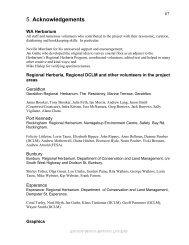Nuytsia 8: 3 (1998) - FloraBase
Nuytsia 8: 3 (1998) - FloraBase
Nuytsia 8: 3 (1998) - FloraBase
You also want an ePaper? Increase the reach of your titles
YUMPU automatically turns print PDFs into web optimized ePapers that Google loves.
Paul G. Wilson, Helipterum: Part 1<br />
bracts, cartilaginous and prominently thickened with narrow scarious shortly ciliate margin and<br />
scarious ciliate apex, somewhat boat-shaped, hispidulous abaxially. Receptacle broad-conical, smooth,<br />
glabrous. Florets discoid, a few outer female, remainder bisexual. Female florets: corolla very narrowtubular<br />
2-2.5 mm long, narrow-urceolate at apex, eventually curved outwards, very shortly 3-dentate,<br />
minutely and sparsely glandular puberulous with uniseriate hairs; inner cells of urceolate portion with<br />
sinuate margins, lobes densely papillose within; pappus a short corona of barbellate scales, sometimes<br />
with one shortly plumose bristle. Bisexual florets: corolla narrow-tubular, urceolate above, minutely 4dentate,<br />
c. 2.5 mm long, at first erect eventually curved outwards, otherwise as in female florets; antherappendage<br />
oblong, very thin, cells narrow-oblong, unthickened; anther tails filamentous, shorter than<br />
collar; style apex truncate; achene narrow-cylindrical, c. 1.8 mm long, minutely puberulous with 2-celled<br />
tooth-like hairs rounded at apex; pericarp diaphanous; testa leathery, smooth, without crystals; boss<br />
a minute narrow ring; pappus bristles 3-4, linear-acuminate, shortly plumose, c. 2.5 mm long, persistent,<br />
Triptilodiscus pygmaeus Turcz., l.c. - Helipterum pygmaeum (Turcz.) Druce in Hayward & Druce,<br />
Advent. Fl. Tweedside 103(1919) comb. illeg. Type: Western Australia, J. Drummond 5th coll. n.54 (iso:<br />
MEL 109204).<br />
Dimorpholepis australis A. Gray, l.c. - Helipterum dimorpholepis Benth., Fl. Austral. 3:650(1867) nom.<br />
illeg. - Argyrocome dimorpholepis Kuntze, Revis. Gen. Pl. 1:309(1891). - Helipterum australe<br />
(A. Gray) Druce, Bot. Exch. Club Brit. Isles 1916, 4:627(1917). Type citation: 'Hab. South-western<br />
Australia, Drummond. Also in the interior of Eastern Australia, at Bathurst Plains, Fraser; and Nangers,<br />
Captain M'Arthur.’ Syntype: J. Drummond 54 (K, photo seen).<br />
Duttonia sessiliceps F. Muell., Linnaea 25:410(1853). Type citation: 'In pratis prope rivum Rocky-creek.’<br />
Lectotype (here chosen): Rocky Creek, Oct. 1851, F. Mueller (lecto: MEL 109152; isolecto: MEL 109197).<br />
There is uncertainty over the publication dates of Triptilodiscus Turcz. and Dimorpholepis A. Gray.<br />
The former name was published in the Bull. Soc. Imp. Naturalistes Moscou vol.24 part 2 no. 3 which was<br />
sent to the Censor on 15 August 1851 and presented to the Society on 5 November 1851 (New Style<br />
calendar). The latter name was published as tab. 856 of the Icones Plantarum which appeared between<br />
September and November 1851 or possibly later, fide C. Jeffrey in litt. I have adopted the Turczaninow<br />
name, as did Laurie Haegi (1986), since there is the greater likelihood of it having priority.<br />
This genus is closely related to Haegiela which shares the same branching habit of the conflorescence,<br />
as well as the same hair type, and similar corolla and achene characters. Haegiela differs principally in<br />
the absence of a pappus, the presence of crystals in the testa, and the presence of unthickened inner<br />
involucral bracts.<br />
Haegiela P. Short & Paul G. Wilson<br />
Haegiela P. Short & Paul G. Wilson, Muelleria 7:259(1990). Type: Haegiela tatei (F. Muell.) P. Short &<br />
Paul G. Wilson<br />
For description and discussion see Short & Wilson, op.cit.<br />
421




